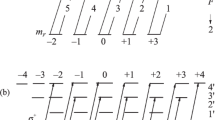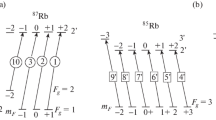Abstract
Transitions Fe − Fg = ΔF = ±2 between the excited and ground levels of the hyperfine structure of the Cs D2 atomic line in an external magnetic field of 300–3000 G have been studied for the first time with the use of σ+ and σ− circularly polarized radiation. Selection rules forbid these transitions in zero magnetic field. At the same time, the probabilities of these transitions in a magnetic field increase significantly; for this reason, we refer to these transitions as magnetically induced transitions. The following rule has been found for the intensities of 24 magnetically induced Fg = 3 → Fe = 5 and Fg = 4 → Fe = 2 transitions: the intensities of magnetically induced transitions with ΔF = +2 are maximal (the number of such magnetically induced transitions is also maximal) in the case of σ+ polarized radiation, whereas the intensities of magnetically induced transitions with ΔF = −2 are maximal (the number of such transitions is also maximal) in the case of σ− σ+ and σ− polarized radiation can reach several orders of magnitude; i.e., anomalous circular dichroism is observed. For an experimental test, absorption spectra of a Cs-filled nanocell with the thickness equal to half the wavelength of resonant laser radiation = 852 nm have been analyzed in order to separately detect magnetically induced transitions. The experiment is in good agreement with the theory. Possible applications have been discussed.
Similar content being viewed by others
References
D. Meschede, Optics, Light and Lasers (Wiley-VCH, Weinheim, 2007).
D. Budker, D. F. Kimball, and D. P. DeMille, Atomic Physics, An Exploration through Problems and Solutions (Oxford Univ. Press, Oxford, UK, 2010).
M. Auzinsh, D. Budker, and S. M. Rochester, Optically Polarized Atoms: Understanding Light-Atom Interactions (Oxford Univ. Press, New York, 2010).
P. Tremblay, A. Michaud, M. Levesque, S. Thériault, M. Breton, J. Beaubien, and N. Cyr, Phys. Rev. A 42, 2766 (1990).
E. B. Aleksandrov, G. I. Khvostenko, and M. P. Chaika, Interference of Atomic States (Nauka, Moscow, 1991; Springer, Berlin, Heidelberg, 1993).
A. Sargsyan, A. Tonoyan, G. Hakhumyan, A. Papoyan, E. Mariotti, and D. Sarkisyan, Laser Phys. Lett. 11, 055701 (2014).
S. Scotto, D. Ciampini, C. Rizzo, and E. Arimondo, Phys. Rev. A 92, 063810 (2015).
A. Sargsyan, E. Klinger, H. Hakhumyan, A. Tonoyan, A. Papoyan, C. Leroy, and D. Sarkisyan, J. Opt. Soc. Am. B 34, 776 (2017).
M. Ilchen, N. Douguet, T. Mazza, et al., Phys. Rev. Lett. 118, 013002 (2017).
A. Sargsyan, G. Hakhumyan, R. Mirzoyan, and D. Sarkisyan, JETP Lett. 98, 441 (2013).
A. Sargsyan, G. Hakhumyan, C. Leroy, Y. Pashayan-Leroy, A. Papoyan, and D. Sarkisyan, Opt. Lett. 37, 1379 (2012).
G. Dutier, A. Yarovitski, S. Saltiel, A. Papoyan, D. Sarkisyan, D. Bloch, and M. Ducloy, Europhys. Lett. 63, 35 (2003).
A. Sargsyan, A. Tonoyan, G. Hakhumyan, C. Leroy, Y. Pashayan-Leroy, and D. Sarkisyan, Europhys. Lett. 110, 23001 (2015).
J. Keaveney, I. G. Hughes, A. Sargsyan, D. Sarkisyan, and C. S. Adams, Phys. Rev. Lett. 109, 233001 (2012).
A. Sargsyan, E. Pashayan-Leroy, C. Leroy, Yu. Malakyan, and D. Sarkisyan, JETP Lett. 102, 487 (2015).
A. Sargsyan, A. Tonoyan, R. Mirzoyan, D. Sarkisyan, A. Wojciechowski, and W. Gawlik, Opt. Lett. 39, 2270 (2014).
E. J. Angstmann, T. H. Dinh, and V. V. Flambaum, Phys. Rev. A 72, 052108 (2005).
E. Arimondo, M. Inguscio, and P. Violino, Rev. Mod. Phys. 49, 31 (1977).
M. Zentile, J. Keaveney, L. Weller, D. J. Whiting, C. S. Adams, and I. G. Hughes, Comput. Phys. Commun. 189, 162 (2015).
B. A. Olsen, B. Patton, Y. Y. Jau, and W. Happer, Phys. Rev. A 84, 063410 (2011).
L. Weller, K. S. Kleinbach, M. A. Zentile, S. Knappe, I. G. Hughes, and C. S. Adams, Opt. Lett. 37, 3405 (2012).
A. Sargsyan, A. Papoyan, I. G. Hughes, Ch. S. Adams, and D. Sarkisyan, Opt. Lett. 42, 1476 (2017).
Author information
Authors and Affiliations
Corresponding author
Rights and permissions
About this article
Cite this article
Sargsyan, A., Tonoyan, A., Hakhumyan, G. et al. Magnetically Induced Anomalous Dichroism of Atomic Transitions of the Cesium D2 Line. Jetp Lett. 106, 700–705 (2017). https://doi.org/10.1134/S0021364017230126
Received:
Accepted:
Published:
Issue Date:
DOI: https://doi.org/10.1134/S0021364017230126




